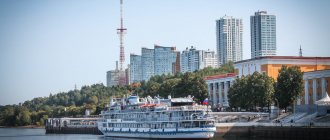For other places with the same name, see Uglegorsk.
City in Sakhalin Oblast, Russia
| Uglegorsk Uglegorsk | |
| City [1] | |
| Coat of arms | |
| Location of Uglegorsk | |
| Uglegorsk Location of Uglegorsk Show map of Russia Uglegorsk Uglegorsk (Sakhalin region) Show map of Sakhalin region | |
| Coordinates: 49°04'N 142°02'E / 49.067°N Latitude 142.033°E / 49.067; 142.033 Coordinates: 49°04'N 142°02'E. / 49.067 ° N Latitude 142.033°E / 49.067; 142,033 | |
| A country | Russia |
| Federal subject | Sakhalin region [1] |
| Administrative region | Uglegorsk district [1] |
| City of district significance | Uglegorsk [1] |
| Based | 1905 |
| City status from | 1946 |
| Height | 15 m (49 ft) |
| population size (2010 Census) [2] | |
| • General | 10 381 |
| Administrative status | |
| • Capital from | Uglegorsk district [1], city of district significance Uglegorsk [1] |
| Municipal status | |
| • Municipal district | Uglegorsk municipal district [3] |
| • Urban village | Uglegorsk urban settlement [3] |
| • Capital from | Uglegorsk municipal district [3], urban settlement Uglegorskoe [4] |
| Timezone | UTC+11 (MSK+8[5]) |
| Postal code [6] | 694920, 694923, 694929 |
| Dialing code(s) | +7 42432 [7] |
| OKTMO ID | 64652101001 |
Uglegorsk
(Russian: Uglegorsk) is a coastal port city and administrative center in Uglegorsk District in Sakhalin Oblast, Russia, located on the western coast of Sakhalin Island, 277 km (172 mi) northwest of Yuzhno-Sakhalinsk, the administrative center of the region. Population: 10,381 (2010 census); [2] 13,396 (2002 census); [8] 18,402 people (1989 census). [9]
History[edit]
It was founded as Esutoru
(恵須取)恵須取町, meaning "between the capes" in the Ainu language, during Japanese rule in 1905[
edit
] It came to Soviet control along with the rest of Sakhalin Island with Japan's defeat in World War II . For some time, Uglegorsk was considered as a potential site for the new capital of the Sakhalin region. [10]
It received city status in 1946 along with its current name. The name Uglegorsk means “coal mountain”. [ citation needed
]
Uglegorsk
(Sakhalin region)
OKATO code:
64252501
Founded:
after 1905
City since:
1946 City of regional subordination
Center:
Uglegorsk district
Urban-type settlements, population as of 01/1/2021
| Shakhtersk | 6.1 |
| The city was formerly called: | ||
| Esutoru | 1946 | |
| Telephone code (reference phone) | |
| 42432***** | — |
Deviation from Moscow time, hours:
8
Geographical latitude:
49°04′
Geographical longitude:
142°03′
Altitude above sea level, meters:
15 Sunrise and sunset times of the Sun and Moon in the city of Uglegorsk
Climate[edit]
Uglegorsk has a humid continental climate (Köppen Dfb
). The weather on the western side of Sakhalin tends to be drier and more stable than on the eastern side, as winds from the combined force of the Siberian High and Aleutian Low run almost parallel to the coast with very little movement across the water. Moreover, winds from summer minimums tend to lose some of their moisture over the island's mountains.
| Climate data for Uglegorsk (1939-1964) | |||||||||||||
| Month | Jan | Feb | Mar | Apr | May | Jun | Jul | Aug | Sep | October | But I | December | Year |
| Record high °C (°F) | −3 (27) | −1 (30) | 4 (39) | 11 (52) | 18 (64) | 21 (70) | 25 (77) | 25 (77) | 23 (73) | 17 (63) | 8 (46) | 1 (34) | 25 (77) |
| Average high °C (°F) | -10,7 (12,7) | -7,9 (17,8) | -2,4 (27,7) | 4,6 (40,3) | 10,3 (50,5) | 14,8 (58,6) | 19,1 (66,4) | 21,1 (70,0) | 17,3 (63,1) | 9,7 (49,5) | 0,1 (32,2) | — | 5,7 (42,3) |
| Daily average °C (°F) | -15,4 (4,3) | -13,7 (7,3) | -8,1 (17,4) | 0,6 (33,1) | 7,5 (45,5) | 13,7 (56,7) | 17,2 (63,0) | 17,1 (62,8) | 12,2 (54,0) | 4,9 (40,8) | -4,9 (23,2) | -12,4 (9,7) | 1,6 (34,9) |
| Average low °C (°F) | -19,4 (-2,9) | -17,8 (0,0) | −12 (10) | −3,2 (26,2) | 1,8 (35,2) | 6,7 (44,1) | 11,4 (52,5) | 13,1 (55,6) | 8,3 (46,9) | 1,0 (33,8) | -7,7 (18,1) | −15 (5) | -2,7 (27,1) |
| Record low °C (°F) | -37 (-35) | -33 (-27) | -28 (-18) | −16 (3) | −8 (18) | −2 (28) | 2 (36) | 3 (37) | −1 (30) | −16 (3) | -23 (-9) | -36 (-33) | -37 (-35) |
| Average precipitation, mm (inches) | 32 (1,3) | 20 (0,8) | 25 (1.0) | 34 (1,3) | 46 (1,8) | 44 (1,7) | 71 (2,8) | 73 (2,9) | 77 (3,0) | 69 (2,7) | 59 (2.3) | 50 (2,0) | 600 (23,6) |
| Source: [11] | |||||||||||||
Map
| Uglegorsk: maps |
Uglegorsk: photo from space (Google Maps) Uglegorsk: photo from space (Microsoft Virtual Earth)
| Uglegorsk Nearest cities. Distances in km. on the map (in brackets along roads) + direction. Using the hyperlink in the distance , you can get the route (information courtesy of the AutoTransInfo website) | |||
| 1 | Shakhtersk | 8 () | WITH |
| 2 | Makarov | 73 (232) | SE |
| 3 | Krasnogorsk | 73 (70) | YU |
| 4 | Poronaysk | 77 (158) | IN |
| 5 | Smirnykh | 92 (83) | NE |
| 6 | Testaments of Ilyich (Khabarovsk Territory) | 130 (521) | Z |
| 7 | Sovetskaya Gavan | 130 (543) | Z |
| 8 | Vanino (Khabarovsk Territory) | 131 (504) | Z |
| 9 | Oktyabrsky (Khabarovsk Territory) | 131 (511) | Z |
| 10 | Tomari | 145 () | YU |
| 11 | Chekhov | 183 () | YU |
| 12 | Tymovskoye | 201 (210) | WITH |
| 13 | Alexandrovsk-Sakhalinsky | 202 (266) | WITH |
| 14 | Dolinsk | 203 (362) | YU |
a brief description of
Located on the western coast of Sakhalin Island, on the shore of the Tatar Strait of the Sea of Japan, along the swampy floodplain of the river. Uglegorka, 359 km northwest of Yuzhno-Sakhalinsk, 150 km north of the railway. Ilyinsk station. Port.
Territory (sq. km): 27
Information about the city of Uglegorsk on the Russian Wikipedia site
Historical sketch
Founded after 1905. In 1905-45. as part of Japan, went to Japan according to the Portsmouth Peace Treaty (1905), which ended the Russo-Japanese War of 1904-05. In 1945 it was returned to Russia. Liberated on August 17, 1945 by troops of the 2nd Far Eastern Front.
Until 1946 it was called Esutoru; the name is considered a Japanese corruption of the Ainu Etuuturu - “between the capes” (etu “cape”, uturu “between”). The city of Uglegorsk has been located since 1946 - coal is mined in its vicinity.
Economy
Integrated timber industry enterprise. Factories: pulp and paper, Stroydetal. Food industry enterprises.
Potatoes, cabbage, cucumbers, and tomatoes are grown in the Uglegorsk region.
Near Uglegorsk - coal mining.
| Population by year (thousands of inhabitants) | |||||||
| 1959 | 17.9 | 2000 | 15.7 | 2010 | 11.9 | 2017 | 9.1 |
| 1967 | 17 | 2001 | 15.3 | 2011 | 10.4 | 2018 | 8.9 |
| 1970 | 17.9 | 2003 | 13.4 | 2012 | 10.1 | 2019 | 8.7 |
| 1979 | 18.4 | 2005 | 12.8 | 2013 | 9.9 | 2020 | 8.7 |
| 1989 | 18.4 | 2006 | 12.5 | 2014 | 9.6 | 2021 | 8.4 |
| 1992 | 19.1 | 2007 | 12.3 | 2015 | 9.4 | ||
| 1996 | 17.5 | 2008 | 12.2 | 2016 | 9.2 | ||
Links[edit]
Notes[edit]
- ^ abcdefgh Law No. 25-ZO
- ^ a b Federal State Statistics Service (2011). “All-Russian Population Census 2010. Volume 1" [All-Russian Population Census 2010, vol. 1]. All-Russian Population Census 2010 [All-Russian Population Census 2010]
. Federal State Statistics Service. - ^ abcd Law No. 524
- Federal State Statistics Service. Federal Agency for Technological Regulation and Metrology. No. OK 033-2013 January 1, 2014 “All-Russian classifier of municipal territories. Code 64 652 101 ". (Federal State Statistics Service. Federal Agency for Technological Regulation and Metrology. No. OK 033-2013 dated January 1, 2014. Russian classification of municipal territories. Code 64 652 101.
). - "On the Calculation of Time". Official Internet portal of legal information
. June 3, 2011. Retrieved January 19, 2022. - Post office. Information and computing center of OASU RPO. ( Post office
).
Search for postal service objects ( postal Search for objects
) (in Russian) - Telephone codes of Sakhalin - Telephone codes of Sakhalin (in Russian)
- ↑
Federal State Statistics Service of Russia (May 21, 2004).
“The population of Russia, the constituent entities of the Russian Federation as part of federal districts, urban settlements, settlements, settlements of 3 thousand or more people” [Population of Russia, its federal districts, federal districts, districts, urban settlements, rural settlements - administrative centers and rural settlements with a population of more than 3,000 people] (XLS). All-Russian Population Census 2002
. - “All-Union Population Census of 1989. The current population of union and autonomous republics, autonomous regions and districts, territories, negative phenomena, urban settlements and rural district centers” [All-Union Population Census of 1989: current population of union and autonomous republics, Autonomous regions and districts , territories, regions, districts, urban settlements and villages performing the functions of district administrative centers. All-Union Population Census of 1989 [All-Union Population Census of 1989]
.
Institute of Demography of the National Research University: Higher School of Economics [Institute of Demography of the National Research University: Higher School of Economics]. 1989 - via Demoscope Weekly
. - Tonai, Yuzuru (2015). Soviet power in South Sakhalin and the Japanese community
. New York: Routledge. paragraph 97. - "Rus' SAYALIN - UGLEGORSK". Centro de Investigaciones Fitosociológicas. Retrieved November 3, 2011.
Russian Bath Kholmsk
Prospects for the area
The Uglegorsk municipal district has a rich past, it has something to be proud of in the present, but its future is even more tempting. Large volumes of prospecting and detailed geological exploration work have been carried out on the territory of the municipality, as a result of which deposits of coal, peat, building stone, sand, sand-gravel mixtures, clayey rocks, gliezhe (burnt rocks), fresh groundwater, and mineral waters have been discovered. In addition, promising areas and areas of distribution of various minerals that need to be studied have been identified. Among them is the Lamanon area, whose predicted oil and gas resources are 5.5 million tons. standard fuel.
The fact that the region has huge coal reserves allows us not only to look boldly into the future, but also to think big. For example, about the possibility of building a state district power station directly near the deposits. Indeed, in this case, fuel transportation will be reduced to a minimum, which means that the costs of producing electrical energy will be significantly reduced. The growing demand for coal in the Sakhalin region also requires the construction of a railway from Ilyinsk station to Uglegorsk. This issue is being seriously discussed at the regional level, and it is this type of land transportation of fuel across Sakhalin that is considered the most effective.
There is growing interest in Uglegorsk coal from foreign consumers, in particular countries in the Asia-Pacific region, which necessitates the need to continue the construction of the quay wall of the Shakhtarsky port. Further reconstruction of the mining port will increase the loading and unloading capacity to 6 million tons per year. Moreover, it should be noted that today not only hard coal, but also brown varieties of coal are in demand.
The development of the coal industry itself will have a positive impact on the economy of the region as a whole. Let's say there remains hope for resuscitation of the agro-industrial complex of the Uglegorsk region to the same extent. There are all the prerequisites for the restoration of agriculture: a favorable climate, developed acreage, pastures, and the availability of fodder.
There are all conditions for the development of tourism in the area. Picturesque places along the coast of the Tatar Strait attract not only Sakhalin residents, but also wildlife lovers from the mainland. Tourists from all parts of the island come to the area to collect wild plants - blueberries, blueberries, raspberries, cranberries, lingonberries, ferns, Chinese lemongrass; mainland guests first of all ask to take them to the berry fields. The residents of the area themselves prefer this pastime. Fishing lovers will find their interest here. During the capelin and smelt season, the shores and beaches of the area are strewn with anglers day and night. There are a lot of shrimp splashing in the coastal waters of the area. Envy there on the mainland!
On the territory of the Uglegorsk region there are also natural areas of medicinal and health value: Lesogorsk thermal springs - a natural monument, Mount Lamanon - a stone canyon with waterfalls, the Bolshoy Nadym River valley - the habitat of a relict walnut grove. Near the village The Blue Lakes are located in Priozernoye, and the Hot Springs, even despite the fact that they are lost in impenetrable forest wilds, are already today in great honor among both Uglegorsk residents and visitors, and therefore are completely inhabited. On this basis, there is quite serious talk in the area and region about the need to develop tourism and medical recreation centers here... All that remains is to pave the first path to the new.
Achievements, successes
Almost the entire life of the Uglegorsk region and all hopes for its further development are connected with coal. The region's coal miners already extract almost 50 percent of this valuable raw material from the total volume of the region's coal industry. And this despite the fact that in the 90s, in the wake of the restructuring of the coal industry, most of the coal mining enterprises in the region were destroyed, almost all the mines were liquidated, and the production facilities serving them were closed. Only the unbending desire of the municipal leadership, residents of the area and coal miners to resist the destructive onslaught saved the industry, and therefore the area as a whole.
In just ten years, the area's coal mining industry was completely restored. According to the program of its development, initiated by the district administration, closed mines were replaced by coal mines. They boldly “took” responsibility for production indicators and record production figures and even became one of the city-forming enterprises. Today, almost two thousand people are employed in this industry in the region. Since 2001, the region's coal miners have confidently maintained production at 1.5 million tons. So much and with such consistency was rarely given out even in socialist times. In 2005, 1.85 million tons of coal were produced.
The flagship of the region's coal industry in terms of development rates is Uglegorskugol LLC, which produces at the Nikolsky and Nikolsky-bis open-pit mines. In 2006, the enterprise celebrated its tenth anniversary and coincided with its first anniversary with the highest production figure - 341 thousand tons per year.
One of the favorites in the coal mining industry of the Uglegorsk region is OJSC Boshnyakovsky Coal Mine. This is the youngest coal mining enterprise in the region; the chief engineer of the former Boshnyakovo mine, E. Chichkanov, was at the origins of its creation. The Boshnyakovsky coal mine is unique. It compensated for the liquidated mine and contributed to the preservation of not only production here, but also the settlement itself - the village of Boshnyakovo. More than three hundred people work at the mine. The enterprise belongs to OJSC Sakhalinugol, and its products are especially in demand on the foreign market, primarily in Japan. Of the 211 thousand tons produced by the Bosniaks in 2005, 140 thousand tons were sent outside the district and region.
ZAO Solntsevskoe also makes its contribution to the development of coal production. This structure includes, among other things, the only mine production in the region, a legacy from former times. This is LLC Sakhalinugol-6, which was formed on the basis of the Udarnovskaya mine, famous throughout the Far East. . On average, it produces 600 thousand tons per year. These figures are very close to those of pre-perestroika times.
The structure of the coal industry of the Uglegorsk region includes both the revived Trestugol LLC (formerly Sosna CJSC), which went through bankruptcy management, and Sakhalinugol-2 LLC, created on the basis of the Solntsevsky open-pit mine. The development of open-pit coal at the Varvarovsky open-pit mine has been reopened... Since 2006, in accordance with the program for the development of the coal industry of the Uglegorsk region, four more open-pit coal deposits will be put up for licensing.
The entire infrastructure of the Uglegorsk region is connected to coal enterprises. First of all, we are talking about transport workers: traditionally, delivery of mined coal to consumers is provided by motor transport enterprises and ships through ports located in the region.
Cargo transportation by land is carried out by Uglegorsk and Shakhterskoye ATP and Ugol-Trans LLC. In 2000, Uglegorsk ATP received the Memorial Sign of the regional governor as the best enterprise of the year in the field of motor transport services in the region.
Shakhterskoe ATP occupies its niche in the coal transportation market. The company has improved working conditions, organized a major overhaul of equipment, and constantly updates its fleet. It should be noted that both Uglegorsk and Shakhterskoe ATP also carry out passenger transportation, providing socially significant services by transporting coal only outside the municipality. This is a structural division of OJSC Sakhalinugol.
Coal for the needs of the regional energy sector is also supplied by water - through the ports of Uglegorsk, Shakhtersk and Boshnyakovo. These enterprises are also involved in the export of coal to Kamchatka, the Koryak Autonomous Okrug, and abroad. It follows that in recent years (2003-2006) it has been increasing its volumes. It processes up to 190 thousand tons per year, although the capacity is designed for 100 thousand tons.
The Uglegorsk municipal district also has its own air gate - the Shakhtersk airport. According to archival documents, this airport was founded in the forties of the last century for military purposes, and it began performing civilian functions in 1957. Today planes from Shakhtersk fly on the route “Khabarovsk – Zonalnoye – Shakhtersk – Khabarovsk”. But the mining airport is also a reserve airfield, ideal from the point of view of geography and climatic conditions. In addition, it has lighting equipment that allows it to land on the runway even in the dark.
An excerpt characterizing Uglegorsk (Sakhalin region)
“If he scolds, I’ll leave,” said Anatole. “I can’t stand these old people.” A? – Remember that everything depends on this for you. At this time, the arrival of the minister with his son was not only known in the maiden's room, but the appearance of both of them was already described in detail. Princess Marya sat alone in her room and tried in vain to overcome her inner agitation. “Why did they write, why did Lisa tell me about this? After all, this cannot be! - she said to herself, looking in the mirror. - How do I get out into the living room? Even if I liked him, I couldn’t be on my own with him now.” The thought of her father's gaze terrified her. The little princess and m lle Bourienne had already received all the necessary information from the maid Masha about what a ruddy, black-browed handsome minister's son was, and about how daddy dragged them with force to the stairs, and he, like an eagle, walking three steps at a time, ran after him. Having received this information, the little princess and M lle Bourienne, still audible from the corridor in their animated voices, entered the princess’s room. – Ils sont arrives, Marieie, [They arrived, Marie,] do you know? - said the little princess, wobbling her belly and sitting heavily on the chair. She was no longer in the blouse in which she had sat in the morning, but she was wearing one of her best dresses; her head was carefully adorned, and there was a liveliness on her face, which, however, did not hide the drooping and deadened contours of her face. In the attire in which she usually wore to social gatherings in St. Petersburg, it was even more noticeable how much she had looked worse. M lle Bourienne also unnoticed some improvement in her outfit, which made her pretty, fresh face even more attractive. – Eh bien, et vous restez comme vous etes, chere princesse? – she spoke. – On va venir annoncer, que ces messieurs sont au salon; il faudra descendre, et vous ne faites pas un petit brin de toilette! [Well, are you still wearing what you were wearing, princess? Now they will come to say that they are out. We’ll have to go downstairs, but at least you’ll dress up a little!] The little princess got up from her chair, called the maid and hastily and cheerfully began to come up with an outfit for Princess Marya and put it into execution. Princess Marya felt insulted in her sense of self-worth by the fact that the arrival of her promised groom worried her, and she was even more insulted by the fact that both of her friends did not even imagine that it could be otherwise. To tell them how ashamed she was for herself and for them was to betray her anxiety; Moreover, to refuse the outfit that was offered to her would have led to lengthy jokes and insistence. She flushed, her beautiful eyes went out, her face became covered with spots, and with that ugly expression of victim that most often settled on her face, she surrendered to the power of m lle Bourienne and Lisa. Both women cared quite sincerely about making her beautiful. She was so bad that not one of them could think of competing with her; therefore, quite sincerely, with that naive and firm conviction of women that an outfit can make a face beautiful, they set about dressing her. “No, really, ma bonne amie, [my good friend], this dress is not good,” said Lisa, looking sideways at the princess from afar. - Tell me to serve, you have masaka there. Right! Well, this may be the fate of life is being decided. And this is too light, not good, no, not good! It was not the dress that was bad, but the face and the whole figure of the princess, but M lle Bourienne and the little princess did not feel this; It seemed to them that if they put a blue ribbon on their hair combed up, and pulled down a blue scarf from a brown dress, etc., then everything would be fine. They forgot that the frightened face and figure could not be changed, and therefore, no matter how they modified the frame and decoration of this face, the face itself remained pitiful and ugly. After two or three changes, to which Princess Marya obediently submitted, the minute she was combed up (a hairstyle that completely changed and spoiled her face), in a blue scarf and an elegant dress, the little princess walked around her a couple of times with her small hand she straightened a fold of her dress here, tugged at a scarf there and looked, bowing her head, now from this side, now from the other. “No, that’s impossible,” she said decisively, clasping her hands. – Non, Marie, decidement ca ne vous va pas. Je vous aime mieux dans votre petite robe grise de tous les jours. Non, de grace, faites cela pour moi. [No, Marie, this definitely does not suit you. I love you better in your gray everyday dress: please do this for me.] Katya,” she said to the maid, “bring the princess a gray dress, and see, m lle Bourienne, how I will arrange it,” she said with a smile of artistic anticipation joy. But when Katya brought the required dress, Princess Marya sat motionless in front of the mirror, looking at her face, and in the mirror she saw that there were tears in her eyes and that her mouth was trembling, preparing to sob. “Voyons, chere princesse,” said M lle Bourienne, “encore un petit effort.” [Well, princess, just a little effort.] The little princess, taking the dress from the maid’s hands, approached Princess Marya. “No, now we’ll do it simply, sweetly,” she said. The voices of her, M lle Bourienne and Katya, who laughed about something, merged into a cheerful babbling, similar to the singing of birds. “Non, laissez moi, [No, leave me,” said the princess. And her voice sounded with such seriousness and suffering that the babbling of the birds immediately fell silent. They looked at the large, beautiful eyes, full of tears and thoughts, clearly and pleadingly looking at them, and realized that it was useless and even cruel to insist. “Au moins changez de coiffure,” said the little princess. “Je vous disais,” she said reproachfully, turning to M lle Bourienne, “Marie a une de ces figures, auxquelles ce genre de coiffure ne va pas du tout.” Mais du tout, du tout. Changez de grace. [At least change your hairstyle. Marie has one of those faces that doesn’t suit this type of hairstyle at all. Change it, please.] “Laissez moi, laissez moi, tout ca m'est parfaitement egal, [Leave me, I don’t care,” answered the voice, barely holding back tears. M lle Bourienne and the little princess had to admit to themselves that the princess. Marya looked very bad in this form, worse than always; but it was already too late. She looked at them with that expression that they knew, an expression of thought and sadness. This expression did not instill fear in them towards Princess Marya. (She did not instill this feeling in anyone.) But they knew that when this expression appeared on her face, she was silent and unshakable in her decisions. – Vous changerez, n'est ce pas? [You will change, won't you?] - said Lisa, and when Princess Marya did not answer anything, Lisa left the room.
Population
| 1925 | 1935 | 2010 |
| 5732 | 18767 | 11 880 |
| Population | |||||||||
| 1959 | 1967 | 1970 | 1979 | 1989 | 1992 | 1996 | 2000 | 2001 | 2002 |
| 17 852 | ↘17 000 | ↗17 921 | ↗18 429 | ↘18 402 | ↗19 100 | ↘17 500 | ↘15 700 | ↘15 300 | ↘13 396 |
| 2005 | 2006 | 2007 | 2008 | 2009 | 2010 | 2011 | 2012 | 2013 | 2014 |
| ↘12 800 | ↘12 500 | ↘12 300 | ↘12 200 | ↘12 025 | ↘10 381 | ↗10 400 | ↘10 116 | ↘9871 | ↘9597 |









